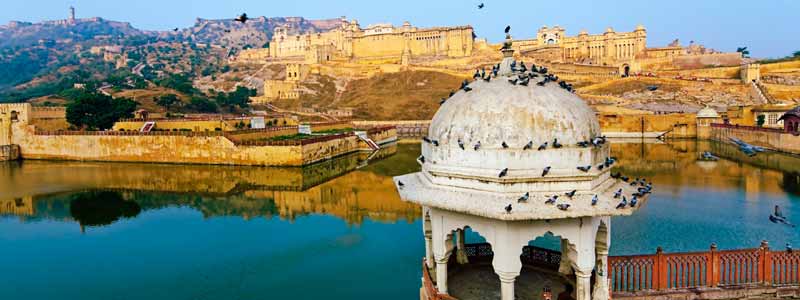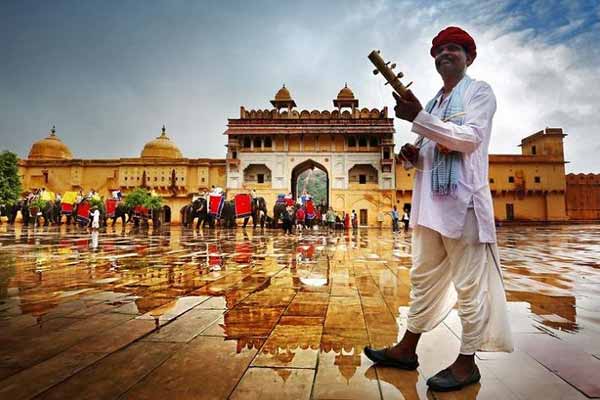Must See Attractions in Jaipur is famously known as “The Pink City of India” for the historic pinkish-orange walls in and around the city. As a matter of fact, the pink here also stands as the colour of hospitality and Jaipur indeed is welcoming. But is it just the pink that defines this place? Definitely not. Sequined sarees, colourful turbans, glowing art too defines the culturally rich Jaipur. It’s truly the most colourful city in India and a heavenly destination for photographers and creative minds.
Jaipur is completely a maze by itself. A maze you would probably fall in love with. To make the most out of this place, here are a few suggestions on places to visit in Jaipur while also experiencing the authentic Rajasthani food and culture Must See Attractions in Jaipur.

Amber Fort and Palace
Amber Fort (or Amer Fort) is the quintessential must-see attraction when you’re here in Jaipur. Built primarily with red and white sandstone, the fort is a grand example of ancient Indian architecture, as the rulers of that time loved using such materials to build their palaces and forts (think about the Taj Mahal, which was built entirely of white marble!).
Be greeted by the Ganesh Pol Gate as you enter the fort. This gate was built exclusively for the royal families to pass through to their private chambers without being disturbed. This beautiful piece is an artwork in itself, with its intricately ornamented carvings accented in a variety of colours.
If you’re looking for an experience that’s both novel and unforgettable, opt for an elephant ride up to the fort! Do note that these are available only until 11am daily, so be sure to plan ahead to avoid disappointment. If you don’t fancy elephants, a trusty 4-wheel drive option up to the fort is available as well Jaipur Tourism.
Once within the grounds, navigate ancient fort walls, meander past the carefully manicured royal gardens and scale up watch towers or wander through the Hall of Mirrors – which features entire ceilings and walls encrusted with gems to mimic the starry sky at night!
After you’re done with Amber Fort, make a request for your driver to stop by the Jal Mahal (a.k.a. The Water Palace) which sits in the middle of the Man Sagar lake! The ancient palace that was previously used for duck-hunting and Maharaja (Indian royalty) picnics is currently off limits to the public, but it definitely makes for a postcard-perfect photo Must See Attractions in Jaipur.
Hawa Mahal
They certainly don’t call Jaipur India’s Pink City for nothing! With many landmarks dressed in rosy pink hues, every corner you turn will have you feeling like you’re in a whole new world altogether. Did you know that the city was painted pink specially to welcome the Prince of Wales and Queen Victoria in 1876 while they were on their India tour? The Maharaja then, Ram Singh, chose pink as it’s a colour that represented hospitality Must See Attractions in Jaipur.
One iconic pink monument is the Hawa Mahal, or the “Palace of Winds”. The structure got its name from its lattice-like design and multiple windows which not only allowed the cool breeze to pass through, but also served to allow women of the royal family to observe street festivals while remaining hidden. This was important as they were under the strict rules of Purdah (Persian for curtain). Purdah is a religious and social practice of female seclusion which is common for both Muslim and Hindu communities, and often involves women using a garment to conceal their faces.
City Palace
Jaipur’s City Palace is another attraction that’s decked in shades of pastel pink. Feel free to go trigger happy and document all the beautiful pink buildings inscribed with white details and patterns. There are lots of photo opportunities here, so take your time to stroll around the extremely spacious palace complex, which includes a number of stunning palaces and buildings.
One important building is the Chandra Mahal palace (recognisable as the yellow building with the Indian flag raised), which is a place of royal residence. However, the ground floor is open to the public, as it is currently used as a museum which showcases different artefacts that were used by the royal families themselves!
Must See Attractions in Jaipur In the middle of the complex lies the Diwan-I-Aam, better known as the Hall of Public Audience. It is now an art gallery which features marble flooring, decorated ceilings and domed patterned “doorways”.
Be it colourful patterned walls and pillars or even pretty decorated gates and doors, such as one that’s affixed with models of peacocks and their colourful tails – there is just so much to see and explore at the City Palace compound, with every nook and cranny holding treasures that are just waiting to be discovered!
Panna Meena Ka Kund
Consisting of alternating faded pink and yellow stairs, the Panna Meena Ka Kund, or Panna Meena Stepwells, are an exceptionally interesting architectural sight. In India, stepwells are usually used as social meeting places, where people would gather and chit-chat while drawing water or to even go swimming in the pool below Must See Attractions in Jaipur.
The most unique charm and mystery of the Panna Meena Ka Kund that usually confounds tourists is that it is nearly impossible to use the same set of stairs to climb up and go down, since its symmetrical design and structure is so confusing. Yet, locals are able to do it easily without batting an eyelash! How mindblowing is that?
Jantar Mantar
Astrology enthusiasts, this is for you! Unbeknownst to the clueless tourist, a bunch of strangely shaped geometrical structures and spheres may appear to be, at best, some unique phenomena of sorts. Perhaps the stonehenge of India? Possible, except that the Jantar Mantar is much more than an interesting placement of objects!
Housing 19 architectural astronomical instruments, the Jantar Mantar is every meteorologist’s dream come true. It features masonry, stone and brass instruments that were designed using ancient astronomy principles of Hindu and Sanskrit texts. Believe it or not, Must See Attractions in Jaipur these instruments are proved to be accurate even until today!
The instruments measure time, predict eclipses as well as locate different stars. There is even a clock that tells time according to where shadows fall, ultimately ascertaining the position of the sun!
Jaigarh Fort
Jaigarh Fort is one of the favourite spots for viewing Amber Palace and the Aravalli hills below. Although its walls and ramparts are pretty impressive, tourists flock here mainly to see the Jaivana cannon, since Jaigarh Fort was the centre of artillery production for the Rajputs (a caste associated with warriorhood).
The Jaivana cannon was the world’s largest cannon on wheels at its point of manufacture in 1720. Although it looks huge and menacing, the cannon was never actually used in real battles since there was never really a need to do so. It was, however, actually fired once in its life, with a charge of 100 kilograms of gunpowder that shot a 50 kilograms ball over roughly the distance of 35 kilometres.
Nahargarh Fort
A stone’s throw away lies another fort that’s equally worth visiting – the Nahargarh Fort. Together with the Amber Fort and Jaigarh Fort, the Nahargarh Fort was also part of the city’s defence system Jaipur Tour Packages.
Filled with lots of different stairways alleys and secret passages to take, Must See Attractions in Jaipur brace yourself for some confusion as you will always find yourself in a different part of the fort with every turn you make!
The fun part about visiting the fort here is that you get to traipse the roof terraces of Nahargarh Fort where you can take in an aerial view of the surroundings and get a closer look at the domes and ridges of the roof.
The fort was also home to Madhavendra Bhawan, which comprised housing for the royalty. Within, you will find many “apartment-styled” suites which were built for the king and his queens. Step into the shoes of royalty as you travel back in time while walking through these hallways of the fort… How grand it all must’ve been!
Albert Hall Museum
Although the Albert Hall Museum may look like just another opulent white marble temple from the outside, this monument holds a totally different significance altogether. The foundation stone of the Albert Hall was laid in honour of Albert Edward, the Prince of Wales, when he visited Jaipur in 1876.
The building was then made into a museum of Industrial Arts which exhibited products of local craftsmen, in an attempt to keep current local craftsmen inspired with the finest examples of artwork and handicraft. By building a museum that displayed handicraft, Must See Attractions in Jaipur it also helped drive the importance of preserving traditions and of artisans.
Today, it is recognised as a place where traditional Indian architecture and craft is appreciated and honoured. It’s definitely worth a visit if you’d like to take a closer look at Indian art and culture!
